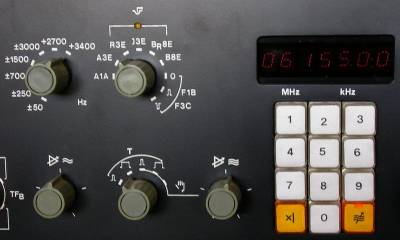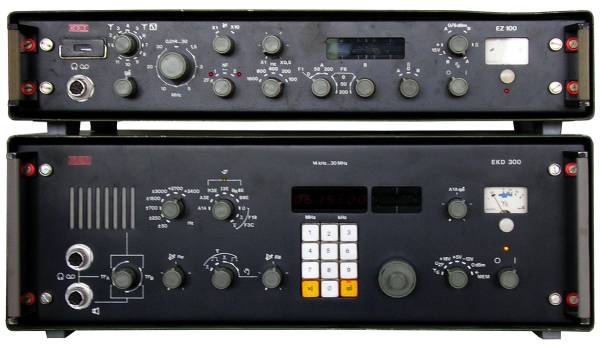Inhaltsverzeichnis
EKD300
Manufactured by RFT / VEB Funkwerk Köpenick, VEB Kombinat Nachrichtenelektronik, Köpenick.
The EKD300 is a professional communications receiver derived from the EKD100 which was equipped with decadic frequency switches.
Technical data
- Frequency range: 14 kHz - 30 MHz
- Frequency display: digital display, 10 Hz
- Frequency memory: none
- Signal processing: RF Gain, Synchronous detector
- Features: Frequency Entry Keypad, RTTY demodulator
+2.7 / +3.4 kHz SSB (-6 dB)
Power supply
- Mains operation: 127, 220 V
- Batteries: 12 resp. 24 V DC
Dimensions
- 540 x 200 x 395 mm, weight 18.5 kg
Accessories
Operation
The set was built by VEB Funkwerk Köpenick and its design is very similar to the professional receivers from Telefunken and Rohde & Schwarz; the military version has a black front panel and a green cabinet, the marine and government version has a grey front panel and a steel-blue cabinet. The set was often used with the antenna diversity and preselector unit EZ100.
The set measures 54 x 20 x 39.5 cm and has a weight of 18.5 kg (without cabinet). In mains operation with 127 or 220 V, the power consumption is about 50 watts; alternatively, operation with 12 or 24 volts DC is possible.
Technically, the set has a modular design in the form of various cassettes, each fitted with printed circuit boards.
On the left side of the front panel there are two six-pole multi-pin connectors for connecting headphones/TB at the top and an external loudspeaker at the bottom, but the built-in monitor speaker can also be used. With the audio distribution switch, the normal AF signal (TF A - Telephony, standard) or the audio signal of the upper sideband in SSB / ISB reception can be fed to the connectors and optionally to the monitor speaker, in the positions TF B the audio signal of the lower sideband in ISB operation (A3Bj) is forwarded to the headphone and speaker. The volume control is right next to it, symbolised by the triangle with arrow and the two wave lines.
Right next to it are the controls for the RF gain control, the control with the triangle/arrow and the three wave lines corresponds to the RF gain control, the switch next to it selects the AGC. The sign Tau with the short or long bar stands for automatic gain control with short (AM/A3, A4A and FM) and long (SSB / A3A, A3J, A3Ba, A3Bj) decay time, the hand symbol for manual control and in between the combination AGC and manual control.
 Above this are the bandwidth and the mode selectors, both with equally somewhat cryptic designations. All filter positions with +/- stand for double sideband filters to be used in CW or AM mode, the positions +2700 / +3400 for receiving the upper sideband (USB) in SSB mode, the bandwidth of the filter for the lower sideband is fixed depending on the receiver variant (on the EKD 315 it is -3400) and the signal can be fed to the headphones with the audio distribution switch.
Above this are the bandwidth and the mode selectors, both with equally somewhat cryptic designations. All filter positions with +/- stand for double sideband filters to be used in CW or AM mode, the positions +2700 / +3400 for receiving the upper sideband (USB) in SSB mode, the bandwidth of the filter for the lower sideband is fixed depending on the receiver variant (on the EKD 315 it is -3400) and the signal can be fed to the headphones with the audio distribution switch.
To set the operation mode switch, some knowledge of the operation modes used in commercial traffic is useful: in position A1, the decoded CW Morse code signal is sent to the TF A output. Position A3 is used for receiving tone modulated telegraphy and normal AM broadcast transmissions, A3A stands for single sideband reception with residual carrier (the receiver automatically locks onto the carrier in a range of +/- 50 Hz and the SSB signal becomes intelligible) and A3J for receiving SSB transmissions without carrier, the audio signal also goes to output TF A. A3Ba receives ISB transmissions (two sidebands with separate information) with residual carrier and A3Bj receives ISB transmissions without carrier, the sideband information goes to channels TF A and TF B. The positions F1 /F4 are used for teletype traffic, depending on the phase position the signal can be inverted with the up or down bar.
The control switch select the different modes of the measuring instrument: in position Y E the antenna signal strength is displayed, in UZF the HF level, 0 dBm the AF level at the audio outputs, furthermore different operating voltages can be controlled.
Right next to it is the main switch, above it the display instrument and the BFO / CW pitch control.
To tune the receiver to a known frequency, the tuning knob or the numeric keypad can be used, an LED line is used for optimal tuning when receiving F1 - radio teletype signals.
For direct frequency entry, the display can first be cleared with [X], the frequency can be entered with the numeric keys, pressing the key with the three wavy lines and arrow activates tuning with the VFO on (key lit) or off (key dark) based on the entered frequency.
For normal AM reception, the set is connected to the mains and an antenna, and the AF distribution switch is set to position TFA on „Internal speaker“. The mode selector switch should be set to A3, the bandwidth switch (above, right next to it) to +/- 3000 Hz, the HF gain control to „T long“. Use the numeric keys or the main tuning to tune to 6.155 MHz and you will hopefully hear the signal of Austrian Radio Vienna, adjust to a comfortable volume with the volume control (triangles with arrow and two wave lines). In the UZF position, the instrument shows the signal level.
One problem with the receiver is the somewhat exotic labelling of the front panel with symbols, in keeping with its professional purpose. It is also unfamiliar that, for example, not all filters can be selected in all operation modes, that during SSB reception the upper sideband is heard in the speaker and the AF channel has to be altered to receive the lower sideband, the unfamiliar operation of the direct frequency input, the HF gain control (not simply MGC / AGC slow / AGC fast), etc.
Once you have overcome all these hurdles (one should not buy such a professional receiver as the first radio after a simple travel radio), the EKD 300 provides is an excellent performer with high frequency accuracy and stability. It's fun to listen for the signal from Radio St. Helena (which only comes up once a year).
There is one remaining downer: the manufacturing quality was apparently somewhat variable. It is not uncommon for receivers from RFT to have functional failures, I have repeatedly had problems with the contacting of the AF distribution switch and initially attributed these to incorrect operation, and vice versa… It is worthwhile to check the receiver briefly before buying.
In summary, this receiver, which is often offered at realistic prices, can fulfil some dreams of DXers - with a set from Rohde & Schwarz or Watkins Johnson the reception would of course not be worse, but the prices, even on the used market, are often in a completely different range. For the price of 250 - 300 euros, you might get several kilograms of rock-solid technology and a receiver designed for professionals.
Technical principle
The signal first passes through an survoltage protector with an incandescent lamp, which is burnt by antenna voltages of over 30 V EMF. This is followed by automatically switched suboctave bandpass filters for preselection. After mixing with the oscillator signal of 70.21400 - 100.19999 MHz (the receiver tunes in 10 Hz steps), the first intermediate frequency of 70.2 MHz is generated; an amplifier stage and a monolithic +/- 8 kHz crystal filter follow. After conversion to the second IF of 200 kHz, the signal passes through the filter bank with the mechanical IF filters, the SSB bandwidth is +300-3400 Hz for the EKD 305/315/325 and 250-600 Hz for the EKD 306/316 versions. In addition, all versions have the dual sideband filters ±50 / ±700 / ±1500 Hz. Next is one of the various demodulators, a product demodulator is used for single sideband reception, the set has several special operating modes.
Components
The set is equipped with solid-state components.

